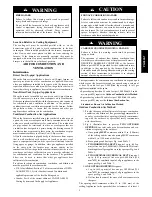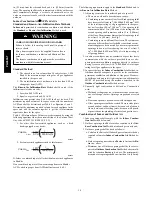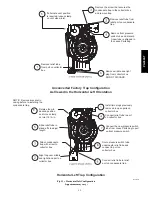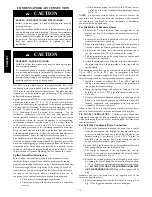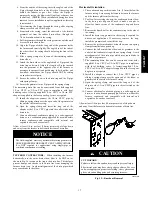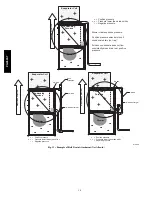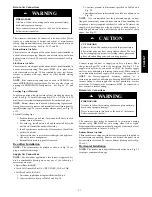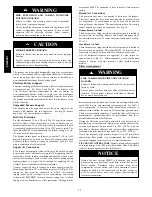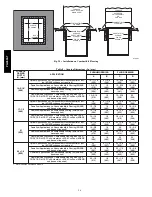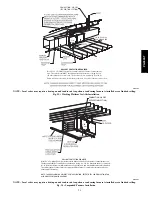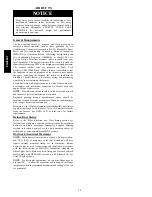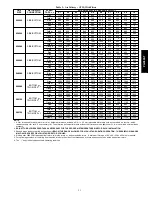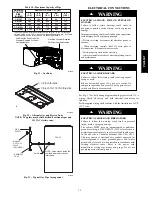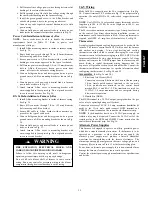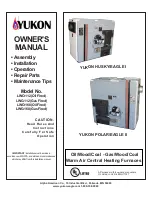
22
FIRE, EXPLOSION, AND CARBON MONOXIDE
POISONING HAZARD
Failure to follow this warning could result in personal
injury, death, or property damage.
Do not install the furnace on its back or hang furnace with
control compartment facing downward. Safety control
operation will be adversely affected. Never connect
return--air ducts to the back of the furnace.
!
WARNING
MINOR PROPERTY HAZARD
Failure to follow this caution may result in minor property
damage.
Local codes may require a drain pan under entire furnace and
condensate trap when a condensing furnace is used in an attic
application or over a finished ceiling.
CAUTION
!
The furnace can be installed horizontally in an attic or crawlspace
on either the left--hand (LH) or right--hand (RH) side. The furnace
can be hung from floor joists, rafters or trusses or installed on a
non--combustible platform, blocks, bricks or pad.
Platform Furnace Support
Construct working platform at location where all required furnace
clearances are met. See Table 2 and Fig. 29. For furnaces with
1--in. (25 mm) clearance requirement on side, set furnace on
non--combustible blocks, bricks or angle iron. For crawlspace
installations, if the furnace is not suspended from the floor joists,
the ground underneath furnace must be level and the furnace set on
blocks or bricks.
Suspended Furnace Support
The furnace must be supported under the entire length of the
furnace with threaded rod and angle iron. See Fig. 30. Secure
angle iron to bottom of furnace as shown.
Roll--Out Protection
Provide a minimum 12--in. x 22--in. (305 x 559 mm) piece of sheet
metal for flame roll--out protection in front of burner area for
furnaces closer than 12--in. (305 mm) above the combustible deck
or suspended furnaces closer than 12--in. (305 mm) to joists. The
sheet metal MUST extend underneath the furnace casing by 1--in.
(25 mm) with the door removed.
The bottom closure panel on furnaces of widths 17--1/2--in. (445
mm) and larger may be used for flame roll--out protection when
bottom of furnace is used for return air connection. See Fig. 29 for
proper orientation of roll--out shield.
Supply Air Connections
For a furnace not equipped with a cooling coil, the outlet duct shall
be provided with a removable access panel. This opening shall be
accessible when the furnace is installed and shall be of such a size
that the heat exchanger can be viewed for possible openings using
light assistance or a probe can be inserted for sampling the air
stream. The cover attachment shall prevent leaks.
Connect supply--air duct to flanges on furnace supply--air outlet.
Bend flange upward to 90
_
with wide duct pliers. See Fig. 21. The
supply--air duct must be connected to ONLY the furnace
supply--outlet--air duct flanges or air conditioning coil casing
(when used).
DO NOT
cut main furnace casing side to attach
supply air duct, humidifier, or other accessories. All supply--side
accessories MUST be connected to duct external to furnace main
casing.
Return Air Connections
The return--air duct may be connected to bottom of the furnace.
The side of casing that faces downward may also be used for return
air connection. A combination of the bottom and downward
facing side may also be used. The upward facing side of the casing
cannot be used as a return air connection. See Fig. 28.
Bottom Return Air Inlet
These furnaces are shipped with bottom closure panel installed in
bottom return--air opening. Remove and discard this panel when
bottom return air is used. To remove bottom closure panel, see Fig.
22 or 23.
Side Return Air Inlet
These furnaces are shipped with bottom closure panel installed in
bottom return--air opening. This panel MUST be in place when
side return air inlet(s) are used without a bottom return air inlet.
Not all horizontal furnaces are approved for side return air
connections See Fig. 28. Where required by code, seal bottom
closure to furnace with tape, mastic or other durable sealing
method.
Filter Arrangement
FIRE, CARBON MONOXIDE AND POISONING
HAZARD
Failure to follow this warning could result in fire, personal
injury or death.
Never operate a furnace without a filter or filtration device
installed. Never operate a furnace with filter or filtration
device access doors removed.
!
WARNING
Pressure drop must be taken into account when sizing filters, filter
racks, IAQ devices, and associated system ductwork. See Table 5
for a comparison of Pressure Drop (initial/clean resistance to
airflow) versus Airflow for a variety of filter media types and sizes.
These are representative numbers. Consult the filter or IAQ device
manufacturers’ specification sheet for performance data for a
particular filter media or IAQ device.
Design the filter and associated ductwork for the best match of
pressure drop versus filter size. Best practice usually chooses filter
systems with pressure drops under 0.2 in. W.C. (50 Pa), with the
best blower electrical efficiency and system airflow performance
occurring with filter pressure drops under 0.1 in. W.C. (25 Pa).
Due to the relatively high pressure drops of 1--in. (25 mm) thick
after--market filter media, it is recommended that the filtration
system be designed for at least 2--in. (51 mm) thick media.
TIPS FROM CONTRACTORS:
Install a media cabinet capable
of incorporating a 4--in. (102 mm) thick media filter. This allows
room for future upgrades to other IAQ devices.
Design the duct system FIRST to determine how much
pressure drop may be allowed in the filter system. See the Air
Ducts section. Excessive filter pressure drop often
compromises system airflow and duct performance, causes
inadequate airflow to the furthest ends of the duct system, as
well as causes excess noise and higher than anticipated
electrical consumption.
NOTICE
PG95X
AT


